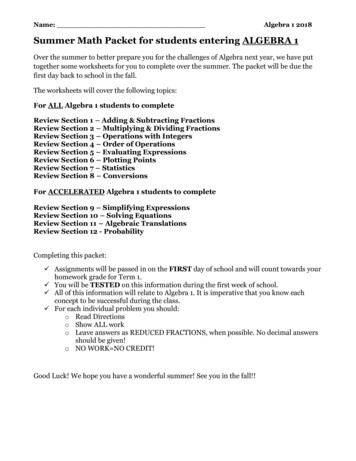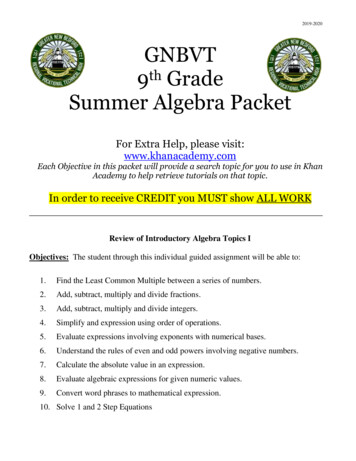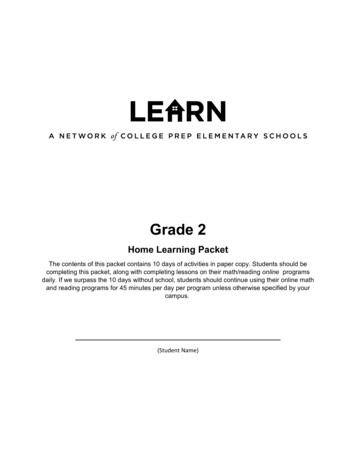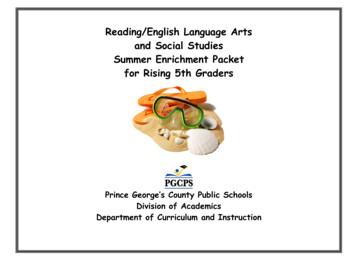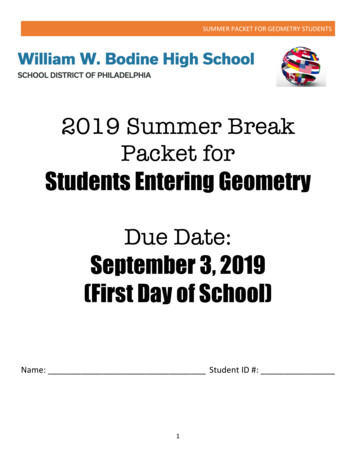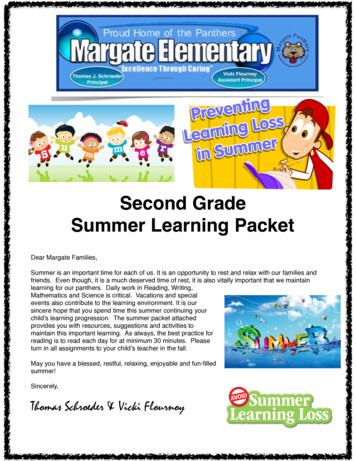
Transcription
Second GradeSummer Learning PacketDear Margate Families,Summer is an important time for each of us. It is an opportunity to rest and relax with our families andfriends. Even though, it is a much deserved time of rest, it is also vitally important that we maintainlearning for our panthers. Daily work in Reading, Writing,Mathematics and Science is critical. Vacations and specialevents also contribute to the learning environment. It is oursincere hope that you spend time this summer continuing yourchild’s learning progression. The summer packet attachedprovides you with resources, suggestions and activities tomaintain this important learning. As always, the best practice forreading is to read each day for at minimum 30 minutes. Pleaseturn in all assignments to your child’s teacher in the fall.May you have a blessed, restful, relaxing, enjoyable and fun-filledsummer!Sincerely,Thomas Schroeder & Vicki Flournoy
DEAR FAMILY,As many of you are planning for your summer activities for your children, we want you toremember to encourage your children to read over the summer break! Reading for the sake of readingwill allow children to explore summer from home, on the road, on vacation or from their own backyard!Many children forget what they’ve learned during the school year while on summer break. This“achievement loss” is also known as the summer slide. Keeping your kids’ engaged with reading overthe summer months will help maintain their academic edge and reduce the summer slide. Children whodo not read over the summer could potentially lose more than 2 months of reading achievement andunfortunately summer reading loss is cumulative.Good News: Margate Elementary encourages reading over the summer by providing your childaccess to myON, an online personalized collection of more than 5,000 digital books that can be read oncomputers, laptops, and other devices anytime, anyplace. We hope you enjoy the 2016 SummerReading Program!Your children can now read with myON over the summer & choose the books that they areinterested in.www.myON.comSchool: Margate Elementary SchoolUsername: Student NumberPassword: Birthday mm/dd/yyyyHAPPY READING!Sincerely,Patti MooreLiteracy Coach
Dear Parents and Guardians,We are very excited to announce that our math program called Reflex willcontinue to be available for the summer. It is important to continue to work onmath during the summer months. Reflex is a game-based system that helps studentswith math fact fluency. Over the course of a student’s first few sessions, Reflexlearns which facts and fact families the student is not yet fluent with and it uses thisinformation when making instructional decisions for that student. This means thatstudents won’t spend time learning facts that they already know.Reflex is a web based program which means students can access the onlinesystem anywhere they have internet. It is also available for use on the ipad.www.reflexmath.comMy user name is: My password is:
ans,''This' packet' is' filled' with' different' engaging' and' fun' reading,' writing,' and' e'you'to'set' aside' some' times' for' your' child' to' work' on' these' skills' to' ensure' continued' progress' book(s)'and'the'date'the'book'was'read.''There' are' also' several' websites' that' can' be' accessed' though' out' the' summer' that' will'help' your' child' with' reading' and' mathematics.' Students' will' continue' to' use' the' m'https://www.reflexmath.com'https://myon.com'
'Monday''(Spelling)''Tuesday''(Reading)'Ask an adult for somecoins. Talk about thosecoins with an adult.Discuss their value.Example: A quarter isworth 25 cents, a dimeis worth 10 cents, andnickel is worth 5 centsand a penny is worth 1cent. Draw the coinsand write their value.Wednesday''(Math)'This is the first week ofsummer vacation! Whatis your favorite summeractivity? Write aparagraph telling whatyou like to do bestduring the summer.Remember paragraphshave an introductorysentence, 3-4 detailsentences and aconcluding sentence.Thursday'(Writing)'Summer(Calendar('Week 1June 13-17Practice reading the listof sight words. Writethem three times each.Then trace over thevowels in a crayon ormarker.Practice reading thefluency passage “How toPlay Running Bases”.Using a timer or asecond hand on a clock,read the passage 3 timesand record yourminutes/seconds foreach time you read. Thegoal is to build yourspeed and fluency.Example:#1- 1 min 42 seconds#2- 1 min 20 second#3- 1 min 6 secondPractice counting by 2’s,5’s and 10’s. After youhave practiced, writeyour 2’s up to 20, 5’s upto 50, and 10’s up to100.Pretend that television,computers, theInternet, smartphones,ipads, and video gameshad never beeninvented. How wouldyou spend your time ona rainy summerafternoon? Write aparagraph describingwhat you would dowithout any technology.Sight WordssaidwaswentandonethewhenWeek 2June 20th-24thSight WordsseemecanitisherewherePractice reading the listof sight words. Use eachof the words in asentence.Practice reading thefluency passage “SoccerCamp”. Using a timer ora second hand on aclock, read the passage3 times and record yourminutes/seconds foreach time you read. Thegoal is to build yourspeed and fluency.Example:#1- 1 min 42 seconds#2- 1 min 20 second#3- 1 min 6 second
Week 3June 27th-July 1stSight WordstheybutitnotgoingtheirbecauseWeek 4July 4th- July 8thSight undayPractice reading the listof sight words. Use eachof the words in asentence.Practice reading the listof sight words. Have anadult give you a “test”.Have an adult checkyour test. If you get anywrong, write them 3times each.Practice reading thefluency passage “A Walkon the Ceiling”. Using atimer or a second handon a clock, read thepassage 3 times andrecord yourminutes/seconds foreach time you read. Thegoal is to build yourspeed and fluency.Example:#1- 1 min 42 seconds#2- 1 min 20 second#3- 1 min 6 secondPractice reading thefluency passage “TheArt Museum”. Using atimer or a second handon a clock, read thepassage 3 times andrecord yourminutes/seconds foreach time you read. Thegoal is to build yourspeed and fluency.Example:#1- 1 min 42 seconds#2- 1 min 20 second#3- 1 min 6 secondTake three dice (if youdon’t have dice, anadult can help youcreate the numbers).Roll the dice and makeup an addition sentencefor each roll. Do this 10times.Have an adult create 10addition problems and10 subtractionproblems. Answer theproblems. Circle theanswers that are evennumber.June is “National FreshFruit and VegetableMonth.” Some kidsdon’t enjoy eating fruitsand vegetables. Write apersuasive letter to afriend who does not likevegetables convincingthem ofthe importance ofconsuming the daily,recommended amountof fruits andvegetables. Give themthree reasons for eatingtheir vegetables andgive them atleast two ideas ofdelicious ways to eatvegetables. Rememberto have a greeting and aclosing on your letter.Example:5 6 4 15On July 4, 1776, theUnited States declaredits independence fromBritain. Every year wecelebrate this holidaywith fireworks. How doyou think this traditioncame to be? Do someresearch to find out whywe use fireworks on the4th of July. Write aparagraph explainingwhat you discovered.
Week 5July 11th- July 15thSight WordsJanuaryFebruaryMarchAprilMayJuneWeek 6July 18th- July22ndSight ctice reading the listof sight words.Complete “Choo-ChooWords” Write yourentire spelling list endto-end as one long word(like a train). Use adifferent color crayon,marker or coloredpencil for each word.Practice reading the listof sight words.Complete “ScrambledUp” Fold your paper inhalf long ways, or hotdog style. Then have anadult at home scrambleup each of your wordson one side of thepaper. Then, on theother side, try tounscramble your wordswithout looking at yourlist.Practice reading thefluency passage “A Jobfor Carla”. Using a timeror a second hand on aclock, read the passage3 times and record yourminutes/seconds foreach time you read. Thegoal is to build yourspeed and fluency.Example:#1- 1 min 42 seconds#2- 1 min 20 second#3- 1 min 6 secondPractice reading thefluency passage “TheTiger Story”. Using atimer or a second handon a clock, read thepassage 3 times andrecord yourminutes/seconds foreach time you read. Thegoal is to build yourspeed and fluency.Example:#1- 1 min 42 seconds#2- 1 min 20 second#3- 1 min 6 secondTake 3 dice and create a3-digit number (if youdon’t have dice, anadult can help youcreate the numbers).Then tell how manhundreds, tens andones are in thatnumber. If you’d like totake to take it one stepfurther, write thenumber in expandedform. Do this 10 times.Example: 3243 hundreds, 2 tens, 4onesExpanded Form:300 20 4Use non-standard units(paper clips, pretzels,etc.) to measure thelength of 5 objectsaround your house.Record your findings.Then use standard units(ruler, yardstick) tomeasure those sameobjects. Compare yourfindings.July is “National PicnicMonth.” If you couldplan the ideal picnic foryour family, what wouldit be like? Write aparagraph that includeswho would be at yourpicnic, where it wouldbe at, what you wouldeat and what activitiesyou would dobefore/after you eat.July 21st is “NationalJunk Food Day.” Thinkabout your favorite typeof junk food and howoften you are allowed toeat this food. Do youthink you think kidsshould be allowed to eattheir favorite foods asmuch as they want?Write a paragraphtaking a stand on thisquestion, and give atleast three reasons tosupport your opinion.
Week 7July 25th- July 29thSight k 8August 1st- August 5thSight WordsalwaysaroundbeenbeforebestbothbuyPractice reading the listof sight words. Use eachof the words in asentence. Make sureyou know the correctmeaning of each wordbefore you start yoursentences.Practice reading thefluency passage“Common Cents”. Usinga timer or a secondhand on a clock, readthe passage 3 times andrecord yourminutes/seconds foreach time you read. Thegoal is to build yourspeed and fluency.Example:#1- 1 min 42 seconds#2- 1 min 20 second#3- 1 min 6 secondPractice reading the listPractice reading theof sight words.fluency passage “TheComplete a “WordMarching Band”. UsingWedge” for each ofa timer or a secondyour words.hand on a clock, readthe passage 3 times andExample: carrecord yourCminutes/seconds forCaeach time you read. TheCargoal is to build yourspeed and fluency.Example:#1- 1 min 42 seconds#2- 1 min 20 second#3- 1 min 6 secondRoll two or three dice.Create 10 numbers andcomplete the followingfor each number:Make a clock face on apaper plate. Practicecounting hours andminutes. Label aquarter past, half pastand a quarter ‘till.July is “NationalRecreation Month.”After you have lookedup the word“recreation” in thedictionary, describeyour favoriterecreational activity.When and where do youlike to do this activity?Why is it your favorite?One moreOne less10 more10 lessAugust 2nd is “NationalIce Cream SandwichDay.” Write aparagraph about yourfavorite dessert andgive at least threereasons why you likethat particular dessert.1.2.3.4.Example: 491. 502. 483. 594. 39
Week 9August 8th- August 12thSight WordsonetwothreefourfivesixseveneightninetenWeek 10August 15th- August 19thSight WordsuponususerightwritegavegoesPractice reading the listof sight words.Complete: “UPPERand lower”- Write thesight words two timeseach. The first time,write each word inUPPERCASE letters.Write your words asecond time inlowercase letters.Practice reading the listof sight words.Complete: “ColorfulWords”. Write eachletter in a differentcolor.Practice reading thefluency passage “Lily’sFirst Movie”. Using atimer or a second handon a clock, read thepassage 3 times andrecord yourminutes/seconds foreach time you read. Thegoal is to build yourspeed and fluency.Example:#1- 1 min 42 seconds#2- 1 min 20 second#3- 1 min 6 secondPractice reading thefluency passage “ABeautiful State”. Using atimer or a second handon a clock, read thepassage 3 times andrecord yourminutes/seconds foreach time you read. Thegoal is to build yourspeed and fluency.Example:#1- 1 min 42 seconds#2- 1 min 20 second#3- 1 min 6 secondUsing coins, think aboutall the ways that youcan make 1.00. Writedown all the ways thatyou came up with.Example: 4 quartersLook throughnewspapers andmagazines for picturesof things with 2- and 3dimensional shapes.Cut them out and sortthem by shape, thenglue them onto yourSummer Journal.Herbert Clark Hoover,the 31st President of theUnited States was bornon August 10, 1874.Would you like to bePresident of the UnitedStates? Why or whynot? What would be themost challenging thingabout being thePresident of the UnitedStates?August 15th is “NationalRelaxation Day.” Writea paragraph thatdescribes one way youhave relaxed and hadfun during this summervacation.
NameDateHow to Play Running BasesHave you ever played a game called “runningbases”? It is a lot of fun! You need two people tocatch the ball and a group of people to runbetween the bases. You also need two bases andone ball. You can use many things as your bases.An old shirt or a paper plate will work fine.To start the game, the catchers throw the ballto each other three times. Then the runners startrunning back and forth between the bases. Thecatchers try to tag them.The runners have to be quick and smart, sothey do not get tagged. After three tags, a runnercan change places with a catcher. Then the gamebegins again.1. What can you use as a base for “running bases”? Macmillan/McGraw-Hill2. Why can’t you play “running bases” with just three people?66 Fluency Assessment Grade 2
NameDateSoccer CampKate and her big brother Ted like toplay soccer. They are always bouncing or kickinga soccer ball. They play in the driveway and kick theball into a net. Sometimes Kate and Ted play onthe grass in their yard. On rainy days, they playin the basement. They go to soccer camp inthe summer.This summer, Ted goes to a different camp.Kate doesn’t want to go to camp by herself. Shefrowns on her way to the field. But then she stopsand smiles. She sees boys and girls running andkicking soccer balls. She will play soccer withmany new friends!1. What do Kate and Ted love to do? Macmillan/McGraw-Hill2. Why doesn’t Kate want to go to camp by herself?62 Fluency Assessment Grade 2
NameDateA Walk on the CeilingHouse flies can be real pests. They can alsocarry germs. But they can be very interesting tojust watch.Did you ever see a house fly walk on theceiling? Did you wonder how house flies coulddo that? Like other insects, all flies have six legs.Each leg ends in a claw. The claw helps all kindsof flies hold on to walls and ceilings.But a house fly has something else. Eachof its claws has a little pad. When the house flywalks on something smooth, the pads becomeflat. The pads also give off a sticky liquid.This liquid acts like a glue. It holds the housefly to the ceiling.Would you like to be like a house fly?Would you like to walk on the ceiling, too?1. What helps house flies walk on ceilings? Macmillan/McGraw-Hill2. Why should you never let flies walk on your food?84 Fluency Assessment Grade 2
NameDateThe Art Museum1. What was different about the art museum in this story?2. What did the children learn at the museum?88 Fluency Assessment Grade 2 Macmillan/McGraw-HillMr. Lawn’s class went to a new art museum.This was not like any other museum they ever saw.Everything in the museum was made from trash.In the first hall, the children saw clothes.Phil noticed that some coats were made from oldflags. The colors looked pretty. Jane spotted big rainhats made from soda bottles. In the next hall, thechildren played with toys. Sarah played with amouse made from boxes. Brooke and Tom raced tincan cars. Kelly played with a ball that was madefrom rubber bands.In the last hall, the class saw a tiny townwith toothpick houses and red doors. The roadswere made from old wood. The stores were madefrom milk jugs. When the children got back to class,they made art from trash, too. The whole schoolcame to see their fine work.
NameDateA Job for Karla1. What is the story mostly about?2. What was written on the poster Karla read?96 Fluency Assessment Grade 2 Macmillan/McGraw-HillKarla watched the actors on stage. Theylooked as if they were having so much fun. Howcould they do it while she could not? Whenever Karlagot on stage, she felt awful. She would feel dizzy,then forget all her lines.Still Karla did enjoy watching the play. Mitchwas so good at saying his lines and Ann lookedlike a real queen. On the way home from school,Karla wondered how she could join her friends inthe play. Surely there was a job for her, even if shewas very shy.The next day Karla saw a poster on the stagedoor. She read it. Karla just knew it was the perfectjob for her.That afternoon, Karla learned how to run aspotlight. Karla could watch the play and bepart of the action. And she never had to stepon stage!
NameDateThe Tiger StoryIn the jungle a very large, striped cat sneaksup on a deer. Then it leaps. The deer gets away. Thetiger does not chase its prey. It just looks forsomething else to eat.Tigers are the world’s biggest cats. One tigercan eat 9 to 15 pounds of meat a day. Tigers likeliving in thick forests or places with tall grass. Theyusually live alone.Tigers do not live in groups like lions do. Theonly time you would see a group of tigers is whena mother tiger has cubs. Cubs stay with theirmothers for about two years.But getting a peek at a tiger with cubs inthe wild is now a rare event. There are not toomany tigers left. Today, twice as many tigers live inzoos as in the wild. Not enough wild places remainfor them to live.2. Where do most tigers live today?98 Fluency Assessment Grade 2 Macmillan/McGraw-Hill1. Tell two facts about tigers that you learned from the story.
NameDateCommon CentsIf you have one hundred of these, you have adollar. What are we talking about? We are talkingabout the penny. The penny is the most common coinin the United States. The U.S. Mint produces morethan one thousand pennies every second. That adds upto about 30 million pennies a day.The copper penny was the first coin made inAmerica. The first one was made in 1787. Since then,there have been many different pictures on pennies.Abraham Lincoln’s picture went on the penny in1909. The other side showed wheat. Today, Lincoln’sface is still on the penny.New pennies are now made of zinc. They haveonly a tiny bit of copper in them. Over the years,some things have changed with the penny, but onething remains the same. A penny is still worthone cent.2. Name two things that have changed about the pennyover time.100 Fluency Assessment Grade 2 Macmillan/McGraw-Hill1. Whose face is on the penny today?
NameDateMike played the flute at school, and Max played thedrums. One day UIFZ decided to form the TDIPPMhT GJSTUmarching band.5IFZ put up a sign asking anyone who QMBZFE B NVTJDBMinstrument to join. They got several SFTQPOTFT UIBU EBZ Chris really wanted to join the band, but he hadone huge problem. He could not play any musicalinstrument. Beth also wanted to join the band, but sheplayed the harp.“How can you be in our band?” Mike asked Beth.“You play the harp sitting down. How can you march?” Then Max had an idea. He invited Beth and Chris tojoin the band.Max said, “Chris will lead the band and pull a wagonwith Beth and her harp on it.”The band members loved Max’s idea and UIFJS NVTJD XBT HSFBU 1. What problem did Chris have in the story?2. How did Max solve two problems with his idea?104 Fluency Assessment Grade 2 Macmillan/McGraw-HillThe Marching Band
NameDateMaine is a beautiful state. .BJOF MJFT along thenortheast coast of the United States. It has along coast with lots of little islands. The coast alsohas beaches and fishing villages.Pine trees once made up most of the TUBUF. That’sXIZ UIF TUBUF is called the Pine Tree State.There are many interesting facts about Maine.Maine makes more wooden toothpicks than any otherstate. Maine is also the place where the BNQ 'JSF (JSMTstarted. The group is now called the BNQ 'JSF #PZT BOE (JSMT It offers outdoor fun to children.Here’s another interesting fact. A 15-year-old boyinvented earmuffs in Maine in 1873.Will you take a trip to Maine? If you do, youwill find yourself in a beautiful and interestingplace 1. What covers most of the state of Maine?2. Describe two interesting facts about Maine.114 Fluency Assessment Grade 2 Macmillan/McGraw-HillA Beautiful State
NameDateNick lived on a ranch where several animals weretrained to perform in movies. Nick’s favorite was Lily,a baby elephant. Lily loved to play USJDLT She would swingher trunk and if it hit him, she would put her head backas if she were laughing. Nick would laugh, too.One day, moviemakers needed a terrific animalperformer. They watched Lily and were impressed by heractions. So the movie people took Lily.Lily was very sad because she missed Nick. Shewould not do her trick with the actors. The movie peopletalked with Nick’s dad BCPVU JU.The next day, Nick appeared at the movie set. WhenLily saw Nick, she hit him with her trunk, then put backher head and laughed. The movie people laughed andclapped loudly. Now they had their star performer. 1. What was Lily’s special trick?2. Why wouldn’t Lily do her trick with the actors?110 Fluency Assessment Grade 2 Macmillan/McGraw-HillLily’s First Movie
Project #1Domain: Number and Operations in Base Ten (NBT)1.NBT.1. Count to 120, starting at any number less than 120. In this range, read and write numerals andrepresent a number of objects with a written numeral.Directions:Fill in the Hundreds Chart below with the appropriate numbers.Next, use the hundreds chart to help you count to one hundred.Color all the numbers yellow that you would use to count by 2s to 100. (2, 4, 6, 8 )Color all the numbers green that you would use to count by 10s to 100. (10, 20 )Color all the numbers red that you would use to count by 5s to 100. (5, 10, 15 )(You will color in the 10s more than once, feel free to color it three times.)1234561121Page 278910
Project #2Domain: Number and Operations in Base Ten (NBT)1.NBT.1. Count to 120, starting at any number less than 120. In this range, read and write numerals andrepresent a number of objects with a written numeral.1.NBT.2. Understand that two digits of a two‐digit number represent amounts of tens and ones.You can represent the number 12 like this:TensOnesOne long rectangle equals 10. A little square equals 1.Now, try to show the number 36 in the same way:TensOnesChoose your own number and represent it below. Number:TensOnesPage 3
Project #3Domain: Geometry (G)1.G.3. Partition circles and rectangles into two and four equal shares, describe the shares using thewords halves, fourths, and quarters, and use the phrases half of, fourth of, and quarter of. Describe thewhole as two of, or four of the shares. Understand for these examples that decomposing into moreequal shares creates smaller shares.Directions:Divide the circle to the right into 4 equal parts(or 4 quarters).Find something in your home that you can divide into equal parts. For example, you could cut a cupcakeinto two equal parts. Or, you could split a candy bar into two equal parts. Write a sentence belowabout what you chose and how you divided it into equal parts.Page 4
Project #4Domain: Operations and Algebraic Thinking (OA)1.OA.1. Use addition and subtraction within 20 to solve word problems Directions:Write a word problem with numbers that add up to less than 20. Solve the problem below.Example:Word Problem: I had 15 gummy bears. My sister gave me 4 more. How many do I have now?Answer: 15 4 19. I drew a picture to help me solve the problem. 19Your Turn!Word Problem:Answer:Page 5
Project #5Domain: Measurement and Data (MD)1.MD.1. Order three objects by length; compare the lengths of two objects indirectly by using a thirdobject.Directions: Cut out the arrows below and arrange them in order from shortest to tallest.Page 6
Project #6Domain: Operations and Algebraic Thinking (OA)1.OA.8. Determine the unknown whole number in an addition or subtraction equation relating threewhole numbers. For example, determine the unknown number that makes the equation true in each ofthe equations 8 ? 11, 5 ? ‐3, 6 6 ?.Directions: Create a change diagram using the model below.Start10Change 5End156‐3348126Page 7
Project #7Domain: Geometry (G)1.G.1. Distinguish between defining attributes (e.g., triangles are closed and three‐sided) versus non‐defining attributes (e.g., color, orientation, overall size); build and draw shapes to possess definingattributes.Directions: Complete the chart below.Name of ShapeSquareDraw theShapeNumber ofSidesNumber ofCornersThe name ofsomething inyour homethat has erPage 8
Project #8Domain: Geometry (G)1.G.3. Compose two‐dimensional shapes (rectangles, squares, trapezoids, triangles, half‐circles, andquarter‐circles) or three dimensional shapes (cubes, right rectangular prisms, right circular cones, andright circular cylinders) to create a composite shape, and compose new shapes from the compositeshape.Directions: Cut out the pictures on the bottom of this page and glue them into the correct section ofthe table below.WholeParts of a Whole (1/2)Page 9
Project #9Domain: Measurement and Data (MD)1. MD.3. Tell and write time in hours and half‐hours using analog and digital clocks.Directions: Assist your child in creating a schedule of a typical week day. Help your child round to thenearest half‐hour.ActivityDraw Time on the ClockExample:Wake UpWrite the Time7:00Page10
Page11
Project #10Domain: Operations and Algebraic Thinking (OA)1.OA.1. Use addition and subtraction within 20 to solve word problems involving situations of adding to,taking from, putting together, taking apart, and comparing, with unknowns in all positions, e.g., usingobjects, drawings, and equations with a symbol for the unknown number to represent the problem.Directions: Solve the following word problems. Show your work. Write the number sentence you usedto solve the problem.Marisa had 18 cars after her Grandma gave her 5 for her birthday. How many cars did she havebefore her birthday?Brian lost 6 toy airplanes at the playground. Before he went to the playground he had 15 airplanes.How many airplanes does he have now that he has lost some?Page12
Project #11Domain: Operations and Algebraic Thinking (OA)1.OA.7. Understand the meaning of the equal sign, and determine if equations involving addition andsubtraction are true or false. For example, which of the following equations are true and which arefalse? 6 6, 7 8‐1, 5 2 2 5, 4 1 5 2.Directions: Write True or False next to each equation.8 816 8 814 6 76 1 1 62 2 1 312 1 10 3Page13
Project # 12Domain: Measurement and Data (MD)1.MD.2. Express the length of an object as a whole number of length units, by laying multiple copies ofa shorter object (the length unit) end to end; understand that the length measurement of an object isthe number of same‐size length units that span it with no gaps or overlaps. Limit to contexts where theobject being measured is spanned by a whole number of length units with no gaps or overlaps.Directions: Use a ruler AND toothpicks or paperclips to measure the length of the following items.Before you measure, estimate (make a good guess) of how long you think the object might be.You can pick your own items to measure for the last six rows in the table.ObjectEstimate howmany incheslong you think itmight beMeasurement with aRulerDesk15 inches18 inchesWater bottlePage14Estimate howmanytoothpicksand/or paperclips long10 toothpickslongMeasurement withToothpicks and/orPaper clipsAbout 8 toothpickslong
Project #13Domain: Number and Operations in Base Ten (NBT)1.NBT.4. Add within 100, including adding a two‐digit number and a one‐digit number, and adding atwo‐digit number and a multiple of 10, using concrete models or drawings and strategies based on placevalue, properties of operations, and/or the relationship between addition and subtraction; relate thestrategy to a written method and explain the reasoning used. Understand that adding two‐digitnumbers, one adds tens and ones, ones and ones; and sometimes it is necessary to decompose a ten.Directions: Color in the hundreds frame below to represent your answer to each addition problem.Example: 10 26 36Challenge Question: How much more would you need to get to 100? (Answer 54)Show the equation 15 6 using the hundreds frame below.Challenge Question: How much more would you need to get to 100?Page15
Show the equation 23 7 on the hundreds frame below.Challenge Question: How much more would you need to get to 100?Page16
Project # 14Domain: Measurement and Data (MD)1.MD.4. Organize, represent, and interpret data with up to three categories; ask and answer questionsabout the total number of data points, how many in each category, and how many more or less are inone category than in another.Directions: Create a Venn Diagram on a topic of your choice.
math during the summer months. Reflex is a game-based system that helps students with math fact fluency. Over the course of a student's first few sessions, Reflex learns which facts and fact families the student is not yet fluent with and it uses this information when making instructional decisions for that student. This means that
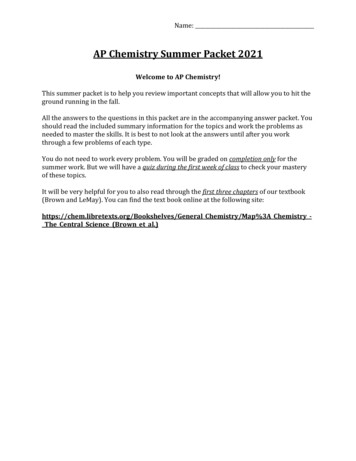
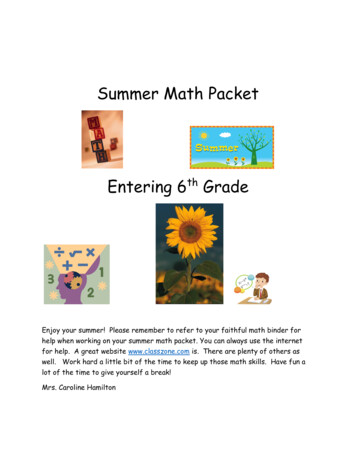
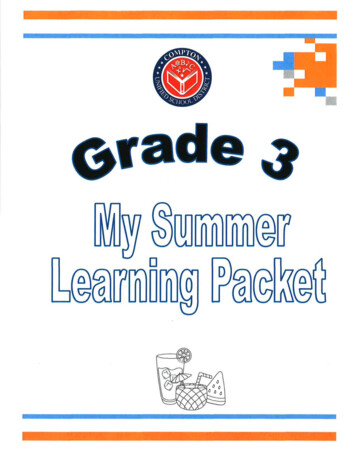
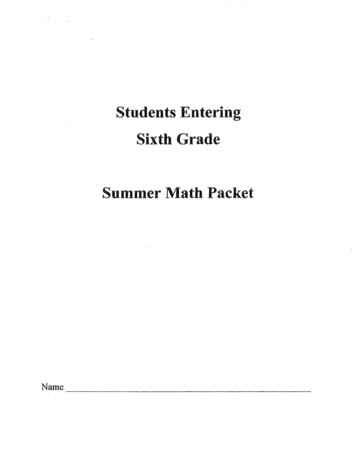
![6th Grade Summer Packet[1]](/img/28/6th-20grade-20summer-20packet-201.jpg)
